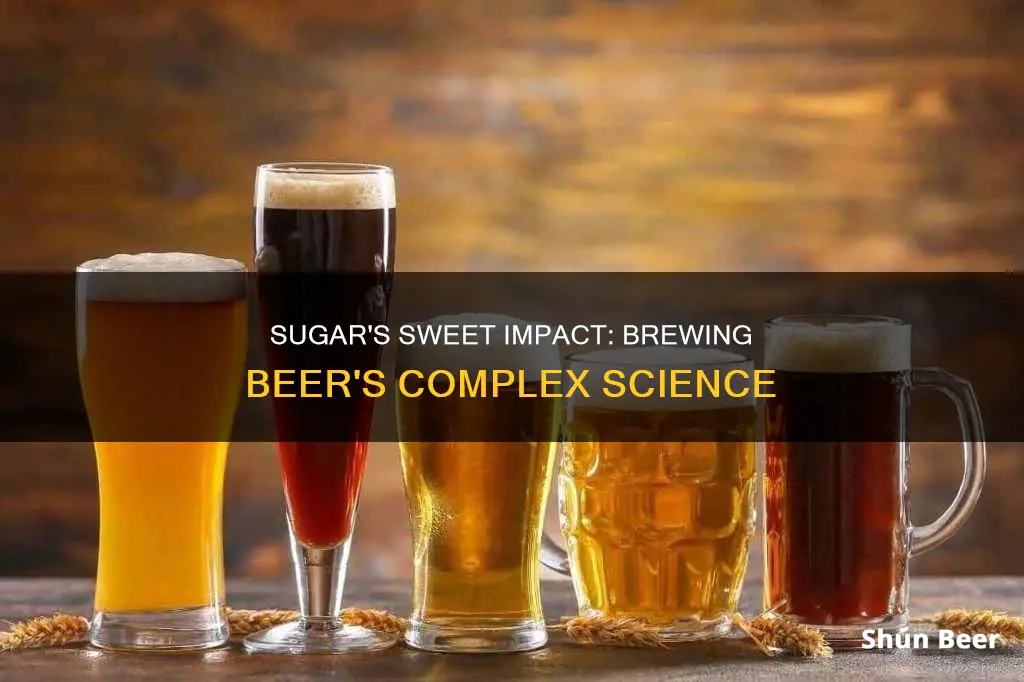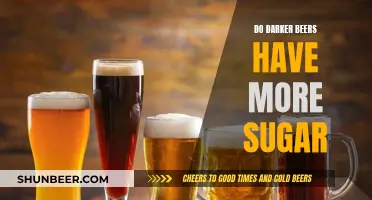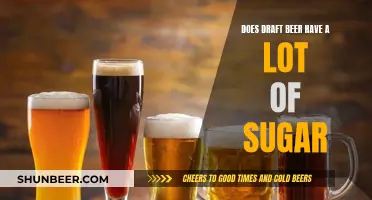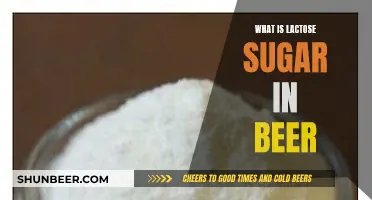
Sugar is an important ingredient in brewing beer. It is used to carbonate the beer, lighten its body, and increase its alcohol content. Brewers use sugar to raise the alcohol level without increasing the body of the beer, which results in a lighter and thinner beer. Sugar also adds flavour to the beer. For instance, honey and maple syrup add their respective flavour notes to the beer. However, the amount of sugar added is crucial, as too much sugar can make the beer overly sweet. Additionally, the type of sugar used can impact the flavour and colour of the beer. For instance, dark Belgian candi sugar will impart a darker colour and a molasses and burnt-caramel flavour to the beer.
What You'll Learn

Sugar will carbonate your beer
If you force carbonate, you will notice little to no difference in the flavour of the beer. The carbonation (if equal) will be the same from force carbonating or bottle conditioning. Carbon dioxide is the same, regardless of the source.
Other recipes add sugars at bottling to give the beer a little extra flavour. These cases are rare, but you might come across a recipe that uses something other than the normal carbonating sugars. Rock candy, Belgium candy, and sugar are all C12H22O11.
Belgian brewers use either liquid Belgian candi sugar or sucrose and dextrose. The liquid syrup used is about 65% sugar. Beers like Chimay, Duvel, or other strong Belgian ales push 9% ABV, but they have a light mouthfeel.
Sugar is also used to prime the beer for carbonation. Corn sugar is the most common example of a simple brewing sugar used for priming. Corn sugar is about 95% solids with 5% moisture. The solids are about 99% glucose. Corn sugar is highly refined and does not contain any corn character. Brewers seeking a corn-like character, for example in a classic American Pilsner, need to cook and mash corn grits as part of an all-grain recipe.
Stella Beer: Sugar Content and Nutritional Facts
You may want to see also

Sugar will increase alcohol content
Sugar will increase the alcohol content in beer. Sucrose sugar (cane or beet sugar) is completely fermentable, and it will not increase the body of the beer as the sugar will convert entirely to alcohol. Alcohol has a lighter density than water, so the beer will be much lighter and thinner.
Sugar is commonly used in Belgian beers to lighten the body of their higher-alcohol beers. For example, Belgian brewers use liquid Belgian candi sugar, which is about 65% sugar, or sucrose and dextrose. Beers like Chimay, Duvel, or other strong Belgian ales push 9% ABV but have a light mouthfeel.
Sugar will increase the alcohol in beer because it converts directly to alcohol. Table sugar will add about 1.046 points per pound per gallon. So, if you add one pound of sugar to a five-pound batch, you will get a gravity boost of about 1.009. If you want to increase the strength of your beer without increasing its body, sugar is the answer.
Some extreme beer recipes with alcohol content close to 20% ABV slowly feed the fermentation with sugar over time. As the yeast ferments the sugars in the beer, some yeast adapts to the harsher conditions in the wort. You can feed the yeast more sugar and nutrients until you reach the desired alcohol content.
Other sugars like honey, maple syrup, or corn sugar will also increase the alcohol content in beer to varying degrees. Maple syrup will add the least (about 1.031 per pound per gallon), while table sugar adds the most.
Beer's Impact on Blood Sugar: Quick Facts
You may want to see also

Sugar can be used to lighten the body of the beer
Sugar can be used to lighten the body of beer. Sucrose sugar (beet or cane sugar) is completely fermentable and will not increase the body of the beer. This is because the sugar converts entirely to alcohol, and since alcohol is lighter than water, the beer becomes much lighter and thinner.
Sugar is often used in Belgian beers to lighten the body of their higher-alcohol beers. Belgian brewers use liquid Belgian candi sugar, or sucrose and dextrose. The liquid syrup is about 65% sugar, and the beer ends up with a light mouthfeel. Beers like Chimay, Duvel, or other strong Belgian ales have an ABV of around 9% but are light in body due to the use of sugar.
Sugar can be added to beer to increase the alcohol content without making the beer heavier. This is achieved by adding table sugar, which will add about 1.046 points per pound per gallon. So, for example, adding one pound of sugar to a five-pound batch will increase the gravity by about 1.009.
Other sugars like honey, maple syrup, or corn sugar can also be used to adjust the fermentables and body of the beer. However, it is important to note that adding too much sugar can make the beer overly sweet, and a high starting gravity may cause fermentation issues.
Beer vs Crown Whiskey: Which Has Less Sugar?
You may want to see also

Sugar can alter the flavour and colour of beer
Sugar can be used in brewing to alter the flavour and colour of beer. Brewers can use sugars such as honey, maple syrup, and molasses to add a characteristic flavour to the beer. For example, honey will add honey-like notes to the beer, while maple syrup will give it a sweeter taste. Molasses will give the beer a rum-like character.
The type of sugar used also affects the colour of the beer. For example, dark Belgian candi will change the colour and flavour of the beer, imparting intense molasses and burnt-caramel characters and possibly darkening the beer. On the other hand, amber candi has a butter caramel flavour and can give the beer a lighter colour.
Additionally, the amount of sugar added to the beer can also affect its flavour. If too much sugar is added, the beer will become overly sweet. Finding the right balance of sugars is crucial in brewing to achieve the desired flavour and colour profile.
Different sugars also have different fermentability rates, which can impact the final product. For example, lactose is a sugar that yeast cannot ferment, so it remains in the beer and adds sweetness and a smooth, "milky" mouthfeel. On the other hand, sucrose is completely fermentable and will not increase the body of the beer as it converts directly into alcohol.
Beer and Blood Sugar: What's the Connection?
You may want to see also

Sugar is used for priming
Priming sugar can be any kind of sugar, such as corn sugar (dextrose), table sugar (sucrose), or dry malt extract (DME). Corn sugar is the most popular option as it is affordable, widely available, and does not alter the flavour of the beer. Table sugar is also commonly used, despite fears that it produces off-flavours. However, these rumours have been debunked, and table sugar is just as effective as corn sugar for priming.
The amount of priming sugar added to the beer is crucial. Too little sugar will result in undercarbonation or flat beer, while too much sugar can cause bottles to overflow or even explode when opened. Therefore, it is important to carefully calculate the amount of priming sugar required, using priming sugar calculators available online.
The process of adding priming sugar is straightforward. The sugar is dissolved in boiled water and then mixed into the beer before bottling. It is recommended to use a bottling bucket, as it allows the sediment to remain in the fermenter and has a spigot for easy bottling. The beer is then bottled and stored, and the yeast and priming solution work together to carbonate the beer.
Priming with sugar is a simple and effective way to improve the taste, aroma, and mouthfeel of home-brewed beer. It is a widely used technique that enhances the drinking experience by adding fizz and improving flavour and aroma.
Dark Beer's Sweet Secret: Sugar Content Surprise
You may want to see also
Frequently asked questions
Sugar is used in the brewing process to carbonate the beer, lighten the body of the beer, and increase the alcohol content.
Common brewing sugars include corn sugar, table sugar, rice syrup solids, honey, maple syrup, and lactose.
Sugar converts directly into alcohol, which has a lower density than water, resulting in a lighter and thinner beer.







